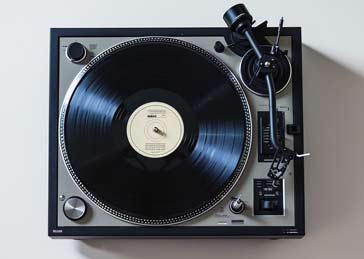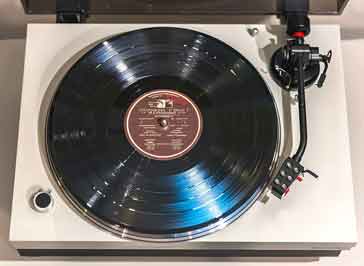Vinyl Record Turntable
The turntable is possibly the most obvious element of any vinyl record or disc playing system - it is more than just a spinning platter as it governs many of the performance aspects of the system
Vinyl Record Player Technology Includes:
Vinyl technology - the basics
Turntable
Pickup arm / tonearm
Pickup cartridge
Stylus technology
The turntable, is the centrepiece of any vinyl record player system, and it is more than just a spinning platform.
The vinyl disc turntable is a complex assemblage of mechanical and electrical engineering which is central to a vibrant listening experience.

In order to understand the highlights and limitations of the turntable, it is necessary to delve into the inner workings of turntables, exploring the different drive methods, key specifications, and factors that influence sound quality.
A vinyl record turntable has a seemingly simple task: to spin the record disc at the right speed, and allow the stylus to track the groove in the right way by having the cartridge swing across the record in the right place while applying the right amount of pressure on the stylus.
But there is much more to the turntable than this - it is possible to buy relatively low cost vinyl disc systems that will work acceptably well, but for the connoisseur, there are top end turntables with eye watering price tags that give very high levels of performance and a great listening experience.
There are many aspects to the turntable and its performance. Aspects such as the drive type, the wow and flutter specifications and a whole lot more.
Vinyl turntable drive methods
One of the most crucial aspects of a turntable is its drive system, responsible for rotating the platter at the correct speed. Three primary drive methods dominate the market:
Belt-Drive: This classic approach utilises a rubber belt to connect the motor, typically positioned beneath the platter, to a pulley on the platter's underside. Belt-drive turntables are known for their isolation from motor vibrations, leading to a quieter and potentially more natural sound. They tend to be lightweight and more susceptible to speed fluctuations caused by external vibrations.
Direct-Drive: In a direct-drive system, the motor is directly connected to the platter spindle, eliminating the need for a belt. This results in high torque and excellent speed stability, making it ideal for DJs who require precise and quick speed adjustments. However, some direct-drive turntables can suffer from motor noise that may be transferred to the audio signal. Careful engineering and high-quality components can minimise this issue in high-end models.
Idler-Wheel Drive: This less common approach uses an idler wheel, a small rotating wheel that makes contact with both the motor pulley and the platter rim. It offers a balance between the isolation of belt-drive and the stability of direct-drive, but requires more maintenance due to the additional moving parts. Idler-wheel drive systems are not as widely produced as the other two methods.
The choice of drive system depends on individual needs and priorities. Audiophiles seeking the purest sound might favour belt-drive for its isolation, while DJs might prioritise the speed stability and robustness of direct-drive.
Motor drives
Regardless of the drive method transferring the motor drive to the turntable platter, one of the major elements of any turntable is the motor. It needs to be able to drive the turntable platter with a minimum amount or rumble, wow, flutter and general vibration.

There is a huge variety of motors that are used, and understanding what is used and how they work helps when selecting a turntable, or when repairing one where the motor may have failed.
A host of different types of mote can be used to drive turntables and it is interesting to note the different types and approaches that are used and available.
Possible the most fundamental element is whether the motor operates on AC or DC.
AC motors: AC motors are the most widely used because they can be run from transformed power taken from the mains or power line system. However there are several different types:
Asynchronous turntable motor: This type of motor does not have its rotation speed determined by the frequency of the incoming AC power waveform. Instead its speed is determined by factors including the voltage and also the load presented to the motor. This enables various methods using feedback to control the speed of the motor as well as options like eddy-current braking.
Synchronous turntable motor: The synchronous motor gains its name from the fact that it run in synchronism with the incoming AC waveform.
Servo AC motor : For this technique, a low voltage AC motor is run from a locally generated signal. Either a mechanical or optical ring on the turntable platter provides the information about the actual turntable speed, and this is then used to generate an error voltage which is used to alter the frequency of the locally generated AC signal. Obviously the internal oscillator used to provide the AC signal must be sufficiently powerful to drive the motor and this means that there are some higher power electronic circuits on the turntable assembly.
Direct drive motor: This technique is aimed at removing the rumble caused by intermediate wheels and bearings. For this, the turntable itself becomes part of the motor. It typically has a magnetic ring clamped to the underside. This follows the rotating field of the stator coils which are suitably mounted.
DC motors: DC motors are far less common, but in theory they could be used, although a source of DC does need to be provided.
Servo-DC motor: In order to regulate the speed of the motor, a servo is normally used. In terms of its operation, a sensor detects the speed at which the turntable is rotating, and this generates a voltage which is compared with a reference. Any error voltage is used to adjust the speed of the turntable platter to ensure it is correct.
Turntable specifications & parameters
Turntables come with various specifications that impact performance and sound quality. Here are some key aspects to consider when evaluating a turntable:
Speed Selection: Most turntables offer 33⅓ and 45 RPM playback speeds, catering to the standard speeds used for LPs and singles, respectively.
Some turntables may incorporate a fine adjustment for the speed to enable exactly the right pitches to be attained for the different notes. This capability tends to be only available for the top end turntables of record decks.
Some turntables might also include 78 RPM for compatibility with older records. As these old 78 rpm records are not widely used these days, many turntables or record decks do not include the capability to play these 78s.
Rumble : Rumble is a very low frequency noise that is generated by the turntable. The mechanical vibrations on the system naturally transfer onto the stylus and can be heard and an annoying background rumble. Naturally this can only be heard on systems that have a good bass response, and where there is a good bass response it can be particularly annoying.
The noise is generated as the bearings move and also by the motor and various wheels that may be used to drive the turntable.
The noise is quoted with reference to a given level. Typically a 1 kHz or 315 Hz signal recorded with a 10cm/s velocity is used for this.
Normally the rumble is weighted to only include the most annoying frequencies and to achieve this one of two standards are normally used. The DIN B standard centres on 315 Hz and has filters sloping away at 12 dB/octave either side of this. The more stringent DIN A standard is flat between 12 and 315 Hz, but slopes away either side of this. This standard will include more of the actual rumbling sounds. Figures for the DIN A standard of -50dB and for the DIN B standard of better than -65dB can be considered to be good.
Wow and Flutter: This specification measures the variations in speed during playback. Normally wow and flutter are grouped together as they are similar in nature if not in frequency.
Wow is typified as a slow cyclic variation in pitch and it is normally the larger of the two issues. It can be caused by uneven turntables and the like. However it can also be caused by warped records and if the disc centre hole is off-centre.
Flutter is a much shorter period variation, and as the name indicates, it sounds a bit like a flutter on a note. It is often greater on servo controlled direct drive turntables and it can also be caused by the way the record disc sits on the mat of the turntable platter.
Normally these quantities are expressed in terms of the RMS value of the variation. The lowest detectable figure is generally accepted as being about 0.2%, and figures for wow and flutter of 0.5% are fairly typical.
Platter Weight and Material: A heavier platter with a non-resonant material like machined aluminium helps maintain speed stability and minimise unwanted vibrations. However it may not be as advantageous where very fast startup is needed.
Turntable mat: Turntable mats on which the vinyl disc sits can be made of any one of a number of different materials. They there to give a protected surface onto which the disc can be placed without damaging it.
In addition to this the mat can also help in reducing the level of rumble because it can help absorb the vibrations and also act as an interface where the vibrations can be partially reflected back.
However the flexibility of the mat can also lead to what are called snatch and also drag, particularly on heavily modulated passages where the force needed to drive the disc around increases.
In view of this, the material chosen for the mat can have a large impact on the performance.
Acoustic feedback: Although this is not normally a specified parameter, it is worth bearing in mind that if the record turntable is placed close to the speakers, it is possible for the sound vibrations from the speakers to be transferred to the turntable, tonearm, etc and appear as vibrations picked up by the stylus and cartridge. This can cause colouration to the sound and in very bad cases it could even give rise to acoustic feedback. The solution is to place the turntable suitably far away from the loudspeakers and to try to vibrationally disconnect the two.
What is a transcription turntable
When looking at hi-fi and audiophile publications it is quite possible the term transcription turntable will be encountered.
The term is often used to describe a turntable which is of the highest quality - one that will give very high quality reproduction.
The term is often interpreted to describe a record turntable that might be used professional situations where transcribing the audio on the discs with the highest precision is needed - for preservation, broadcasting, or the highest quality listening.
One explanation of how the term came into use was because discs specially made for broadcasting in the US are called Transcription discs and the term was probably carried over onto the high quality turntables used for this purpose.
The turntable is one of the most obvious elements of a vinyl disc record playing system. However its performance is often taken for granted. Nevertheless, its performance is critical for the overall performance of the audio system. While it is possible to buy very low cost turntables, they will not have the same performance as those at the higher end of the market.
Some high end turntables offer exceptional performance and enable the best performance to be obtained, but at a significant cost.
More Audio Video Topics:
HDMI
SCART
DisplayPort
DVI
Loudspeaker technology
Headphones & earphones
Bluetooth speakers
Stereo sound
Microphones
Audio compact cassettes
Vinyl record technology
Digital radio
DVB television
Return to Audio / Video menu . . .



